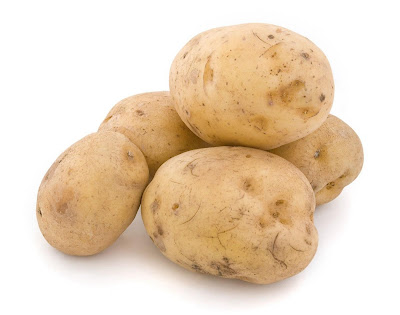 |
| Solanum tuberosum |
Biggest Plant Dictionary | Solanum tuberosum | The potato is a starchy, tuberous crop from the perennial Solanum tuberosum of the Solanaceae family (also known as the nightshades).
The word potato may refer to the plant itself as well as the edible tuber. In the region of the Andes, there are some other closely related cultivated potato species. Potatoes were first introduced outside the Andes region four centuries ago, and have become an integral part of much of the world's cuisine. It is the world's fourth-largest food crop, following rice, wheat, and maize. Long-term storage of potatoes requires specialised care in cold warehouses. kentang " Indonesia called ".
Wild potato species occur throughout the Americas, from the United States to Uruguay. The potato was originally believed to have been domesticated independently in multiple locations, but later genetic testing of the wide variety of cultivars and wild species proved a single origin for potatoes in the area of present-day southern Peru (from a species in the Solanum brevicaule complex), where they were domesticated 7,000–10,000 years ago.Following centuries of selective breeding, there are now over a thousand different types of potatoes. Of these subspecies, a variety that at one point grew in the Chiloé Archipelago (the potato's south-central Chilean sub-center of origin) left its germplasm on over 99% of the cultivated potatoes worldwide.
Potatoes have many benefits. Among potassium, vitamin C (the second source after oren), membekalkan complex carbohydrates and fiber, or gentian to blood sugar (blood sugar) and blood pressure under guard. He also contain adequate vitamins B1, B2 and B3 and a little protein and iron.
 |
| Solanum tuberosum |
Various kasiat potatoes:
· According to research, raw potato juice can help reduce disease affecting the joints (arthritis), muscle inflammation (arthritis). Pain that is caused whiplash or sprains, minor wounds and minor burns, can be legakan with sliced potatoes sticking to the wound or pain that is felt, for 15 minutes or more.
· Sauce that is used for sauce potato salad, are believed to reduce injuries, reduce pain, as well as bacterial contamination. Grated potatoes are placed on the eyelids, were able to eliminate the black spots on the eyes (dark circles) and if mixed with cream, could slow the emergence of wrinkles on the face.
· Potatoes can also whiten and soften hands. It shows the potato not only useful for medicinal purposes. The content of potassium, and Vitamin C in potatoes is suitable for skin care, such as oily and acne. For oily skin, two peeled and shredded potatoes. Then applied to the flat face, leave for half an hour. Clean with clean cold water. As for acne, a thinly sliced potato, stick your whole face. Let until potatoes are dry and gray in color. Clean with cold clean water.
· Potatoes have become friends of all people, who are setting up a diet. So the potato can be an alternative menu for the diet because the potatoes rich in carbohydrates is believed pangganti rice for those who are currently on a diet.
· Vitamin C, also known as a reliever diseases that have been made since the time of the ancestors. You are suffering from warts, immediately apply a fresh piece of raw potato on the warts.
· Potatoes is perfect for those who have ulcer disease or illness mangalami often due to excess stomach acid. For the potatoes contained atropine can memebantu reduce stomach acid and reduce pain in the stomach.
· Usually lysine substances not found in vegetable oils, but there is a lysine in the potato is very important in the growth of body and brain. With potatoes we can consume Vitamin C easily. Because vitamin C in potato does not disappear after cooking because it is surrounded by starch. Although fairly low calorie, potatoes can cause obesity because of the Glycemic Index.
 |
| Solanum tuberosum |
Asia
The potato diffused widely after 1600, becoming a major food resource in Europe and East Asia. Following its introduction into China toward the end of the Ming dynasty, the potato immediately became a delicacy of the imperial family. After the middle period of the Qianlong reign (1735–96), population increases and a subsequent need to increase grain yields coupled with greater peasant geographic mobility led to the rapid spread of potato cultivation throughout China, and it was acclimated to local natural conditions. Boomgaard (2003) looks at the adoption of various root and tuber crops in Indonesia throughout the colonial period and examines the chronology and reasons for progressive adoption of foreign crops: sweet potato, Irish potato, bengkuang (yam beans), and cassava. The potato was introduced in the Philippines during the late 16th century, and to Java and China during the 17th century. It was well established as a crop in India by the late 18th century and in Africa by the mid-20th century.
Varieties
While there are close to 4000 different varieties of potato, it has been bred into many standard or well-known varieties, each of which has particular agricultural or culinary attributes. In general, varieties are categorized into a few main groups, such as russets, reds, whites, yellows (also called Yukons) and purples—based on common characteristics. Around 80 varieties are commercially available in the UK. For culinary purposes, varieties are often described in terms of their waxiness. Floury, or mealy (baking) potatoes have more starch (20–22%) than waxy (boiling) potatoes (16–18%). The distinction may also arise from variation in the comparative ratio of two potato starch compounds: amylose and amylopectin. Amylose, a long-chain molecule, diffuses out of the starch granule when cooked in water, and lends itself to dishes where the potato is mashed. Varieties that contain a slightly higher amylopectin content, a highly branched molecule, help the potato retain its shape when boiled.
No comments:
Post a Comment